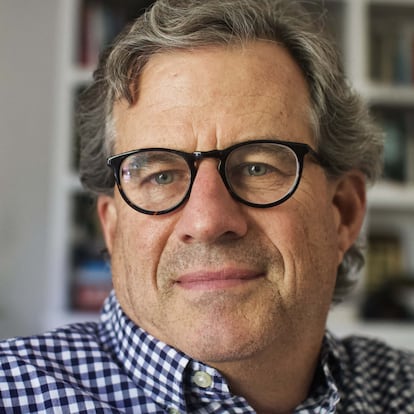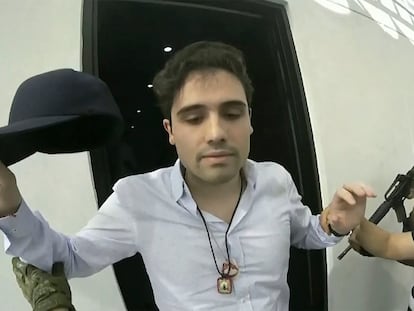How the United States got hooked on fentanyl
The drug, which is responsible for a record number of overdose deaths, began to make inroads in the 2010s, then skyrocketed with the Covid-19 pandemic. Dealers don’t know how to use it so they don’t kill their customers, says Sam Quinones, the great chronicler of the opioid crisis


The story of how the United States got hooked on fentanyl is a classic story of supply and demand creation. It began in the mid-1990s, when pharmaceutical companies such as Purdue aggressively upended the rules of medical marketing and flooded doctors’ offices and medicine cabinets with revolutionary pills called Oxycontin. Not only did the pharmaceutical companies claim that the pills would put an end to all pain once and for all, they also said they weren’t addictive.
When that offer was curbed due to a crackdown on the use and prescription of opioids to treat chronic pain, large numbers of addicts took to the streets looking for heroin, which was cheaper and also more dangerous. By the middle of the last decade — when the opioid epidemic had become an unprecedented health crisis — history took another unexpected turn: a powerful drug that few outside the operating room had heard of until then entered the scene. Fentanyl surpassed all other drugs. In 2022, fentanyl caused around three-quarters of overdose deaths, and according to U.S. authorities, 2023 is expected to set a new record, with close to 110,000 deaths. In other words, more than 2,000 per week.
Sam Quinones, an investigative journalist and writer, is the great chronicler of what narcotic agencies call “the worst crisis in the history of drugs in the United States.” He looked at the opioid crisis in Dreamland, a successful National Book Award-winning book that focused on the ravages of painkillers across vast stretches of the Midwest. That book led to another, The Least of Us, which portrays the United States “in the times of fentanyl and methamphetamine.”

Methamphetamine, he recounts in The Least of Us, prepared the ground for fentanyl. Thanks to it, Mexican drug traffickers embraced the synthetic drug. Up to then, they “had always been the errand boys for Colombians. Meth allowed them to make their own drugs, not rely on criminals from other countries.” At first, Mexican drug traffickers imported fentanyl from China. When Beijing announced a ban in 2019, Chinese chemical companies began selling them the precursors needed to make the potent painkiller. “The Mexicans figured out how to make it in Mexico. And then, all of a sudden it was crossing a much larger amounts all across the border. At first, in powder. Later disguised in counterfeit pills,” Quinones explains in a telephone interview. “From Mexico, it’s coming in many kilos at a time, almost all the time. So now, it’s everywhere in the U.S.”
The father of fentanyl is a Belgian chemist named Paul Janssen. His invention, which is more effective and less expensive than morphine, began to be used in cardiac surgeries and revolutionized medicine. In 1985, Janssen opened the first Western lab in China to make fentanyl.
But away from the supervision of an anesthesiologist, it is a highly deadly substance. The first blow came in 2006, when fentanyl hit the streets of Chicago, where it was known by the nickname “lethal injection.” The drug entered the U.S. after a chemist named Ricardo Valdez-Torres — nicknamed “The Brain” — convinced the men of Mexican drug trafficker Joaquín “El Chapo” Guzmán Loera that they should manufacture fentanyl rather than ephedrine. Valdez-Torres only had time to send 10 kilos to the United States before he was arrested in Mexico. He told police that he sent the drug with a warning that it had to be diluted up to 50 times before being sold. But perhaps those instructions never reached their recipients. Or maybe convincing an addict that what they were dealing with was too strong was too difficult. “The traffickers take over and then of course, they don’t care. They don’t know how to use it. They don’t know how to mix it,” says Quiñones. The police dismantled the laboratory and the drug was nipped in the bud that time.
Creating addicts
The second blow came around 2014 and, this time, nothing could get in the drug’s way. Dealers began cutting other substances, such as cocaine or methamphetamine, with much cheaper fentanyl, so that thousands of people, the ones who didn’t die from an accidental overdose, ended up hooked on something they didn’t even know they were taking. “Not only did they seek to increase their profits, the traffickers were also interested in creating addicts,” says the journalist.
That was one of the reasons that helped the drug break down racial barriers. Quinones explains that the first wave of the opioid crisis, caused by prescription pills, affected a mostly white population (as much as 90%). With fentanyl, it was different: it spread like an invasive species through city corners across the country, taking heroin and other substances by storm, and hitting African-American and Hispanic communities equally hard.
The Least of Us tells the story of the first Black person who died from a fentanyl overdose. His name was Mikey Tanner, and he was from Akron in the state of Ohio. Tanner had battled cocaine addiction for 10 years, but only lasted a couple of months after fentanyl came on the scene.
The Least of Us is full of terrible stories about the people behind the statistics, the faces that together paint a picture of a deeply sick society, beset by grief and isolation. It also weaves the rise of fentanyl with the story of U.S. decline in the 20th century, focusing on cities such as Muncie (Indiana), which was the “world capital” of car gearboxes until everything went to hell, or Kenton (Ohio), a Rust Belt town where high school sports stars ended up hooked on heroin after taking prescription pills for pain.
The Covid-19 pandemic was the last straw. In 2020, overdose deaths rose by 20% to 91,799 cases. In 2021, 106,699 overdose deaths were registered, according to the National Institute of Drug Abuse, a rise of 16%. And in 2022, the Drug Enforcement Agency (DEA) seized 50.6 million fentanyl pills and 10,500 kilos of fentanyl powder, the equivalent of “more than 379 million potentially fatal doses” — more than enough to wipe out the entire U.S. population. “And the one thing they tell you during drug addiction recovery, the most important thing, is to not isolate and of course, during COVID everybody isolated and what’s more, a lot of jobs were lost,” recalls Quinones. “And they were doing meetings with Alcoholics Anonymous and Narcotics Anonymous by Zoom, which is really not a substitute.”
The alarming figures woke up the United States to a problem that has since turned into another political battleground between the U.S. and Mexico. It’s also playing a key role in national politics, with Republicans using the scourge of fentanyl overdoses to criticize the Joe Biden Administration’s border policies and the rise in crime in large cities, which traditionally vote Democrat. San Francisco has become a symbol of the crisis: since 2020, twice as many people have died from overdoses (about 2,000) in the city than from the pandemic. Quinones, who was a reporter for the Los Angeles Times, is “surprised” by the Republican Party’s attacks, “because the truth is, all of this happened under the presidency of Donald Trump. “Locally, I think people are trying to figure it out, unable to cope with it. But this is really a national problem.”
In The Least of Us, Quinones asks two key questions: why would anyone want to take something they know could kill them? And what would make a dealer give their clients something with a high chance of killing them?
To the first, the journalist, who interviewed prominent neuroscientists, replies: “That’s the nature of addiction; it reprograms our brains so that their mission is not to ensure our survival but to pursue the drug.”
To the second, he answers: “It was more potent than any street drugs before it. Anybody selling drugs that didn’t include the powerful boost of fentanyl wasn’t going to have customers for long. Dealers didn’t dare not mix it in.(…) Soon, fentanyl became a market-expansion tool.”
In the interview, Quinones highlighted another unexpected effect: “It’s really spelling the end of the era of recreational drug use in the United States, which has been something that we’ve kind of had as part of our culture. You can’t trust any line of cocaine. You can’t track any pill. You can’t trust any dose of methamphetamine to not have fentanyl. And it could kill you.”
Sign up for our weekly newsletter to get more English-language news coverage from EL PAÍS USA Edition
Tu suscripción se está usando en otro dispositivo
¿Quieres añadir otro usuario a tu suscripción?
Si continúas leyendo en este dispositivo, no se podrá leer en el otro.
FlechaTu suscripción se está usando en otro dispositivo y solo puedes acceder a EL PAÍS desde un dispositivo a la vez.
Si quieres compartir tu cuenta, cambia tu suscripción a la modalidad Premium, así podrás añadir otro usuario. Cada uno accederá con su propia cuenta de email, lo que os permitirá personalizar vuestra experiencia en EL PAÍS.
¿Tienes una suscripción de empresa? Accede aquí para contratar más cuentas.
En el caso de no saber quién está usando tu cuenta, te recomendamos cambiar tu contraseña aquí.
Si decides continuar compartiendo tu cuenta, este mensaje se mostrará en tu dispositivo y en el de la otra persona que está usando tu cuenta de forma indefinida, afectando a tu experiencia de lectura. Puedes consultar aquí los términos y condiciones de la suscripción digital.
More information
Archived In
Últimas noticias
Most viewed
- Sinaloa Cartel war is taking its toll on Los Chapitos
- Oona Chaplin: ‘I told James Cameron that I was living in a treehouse and starting a permaculture project with a friend’
- Reinhard Genzel, Nobel laureate in physics: ‘One-minute videos will never give you the truth’
- Why the price of coffee has skyrocketed: from Brazilian plantations to specialty coffee houses
- Silver prices are going crazy: This is what’s fueling the rally









































